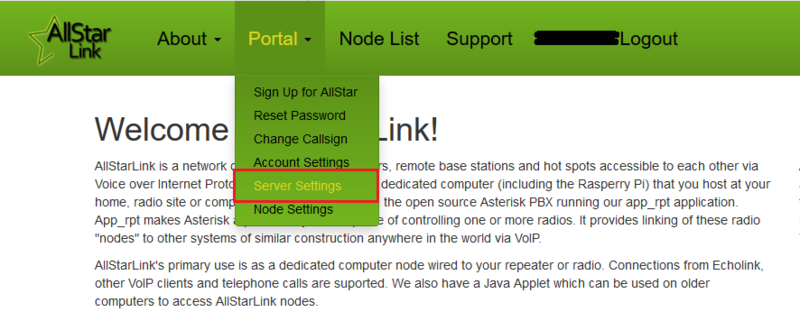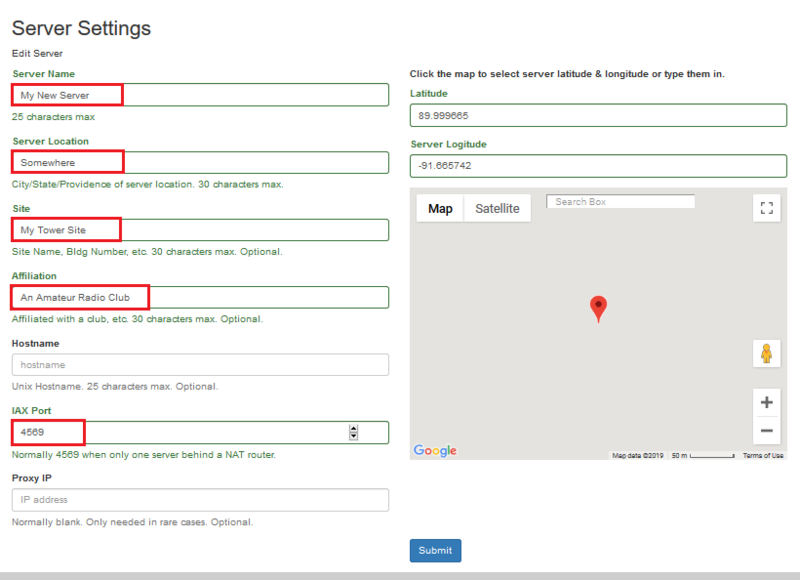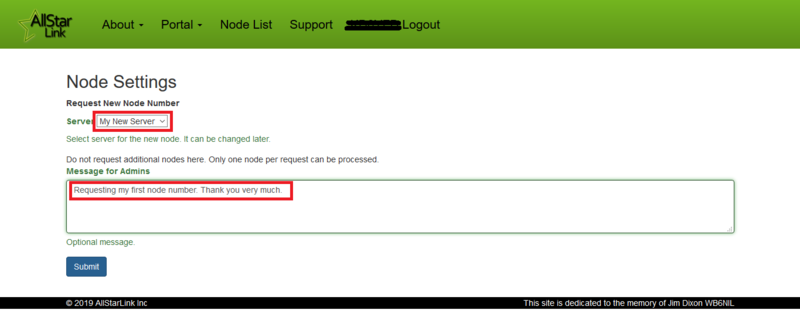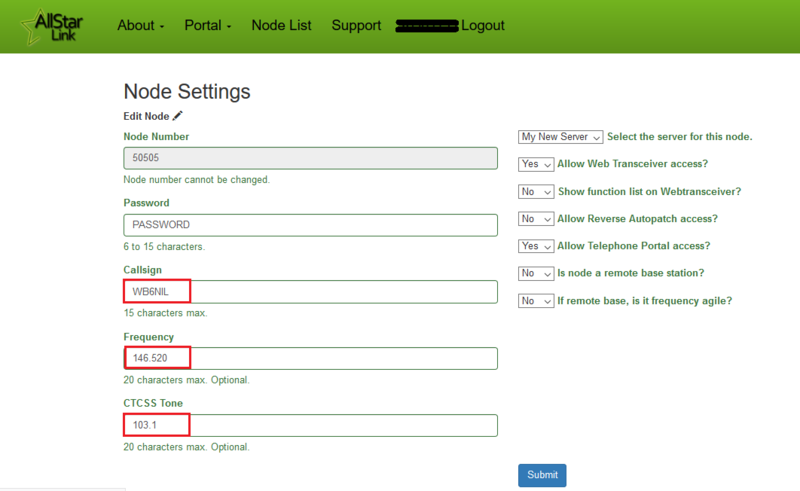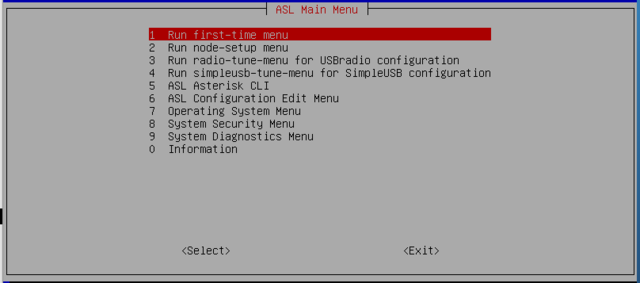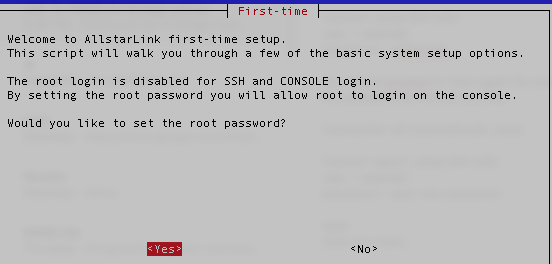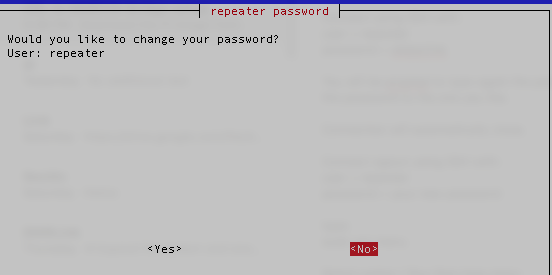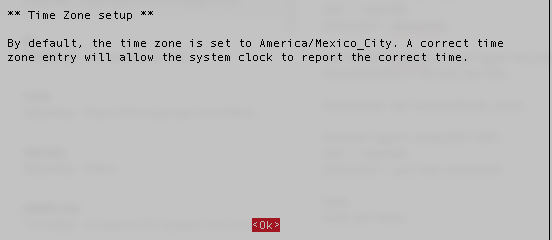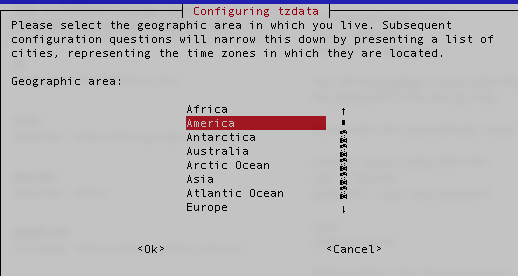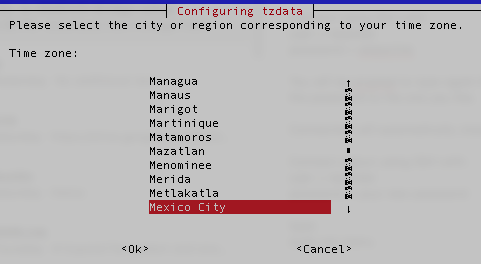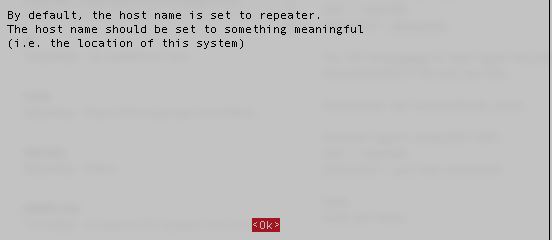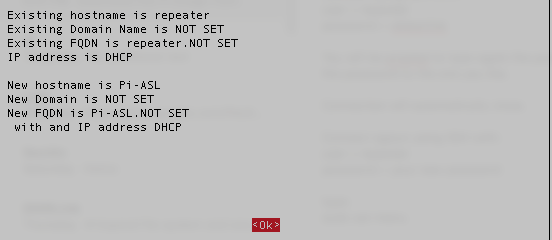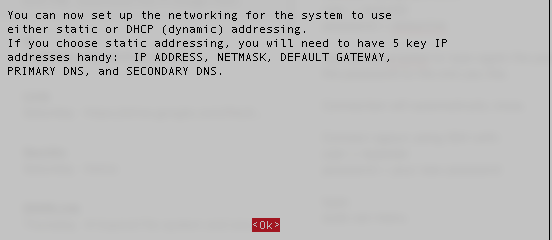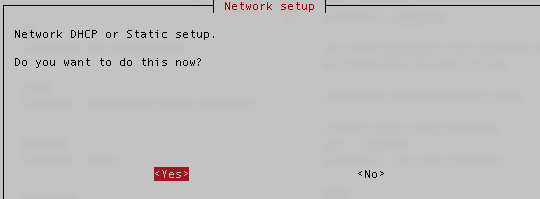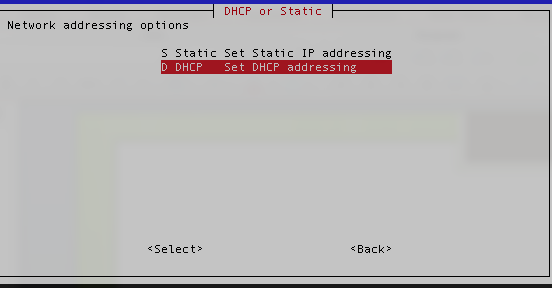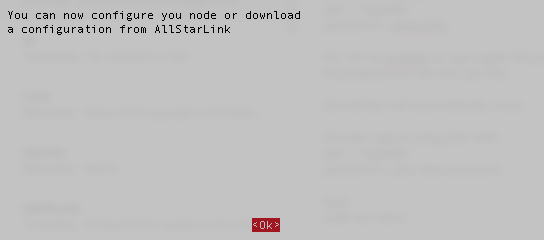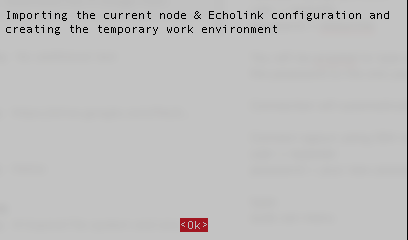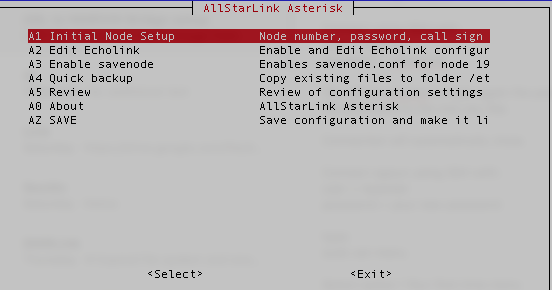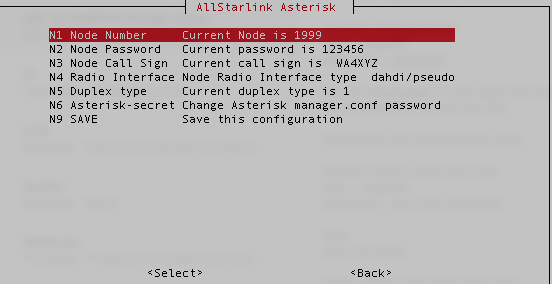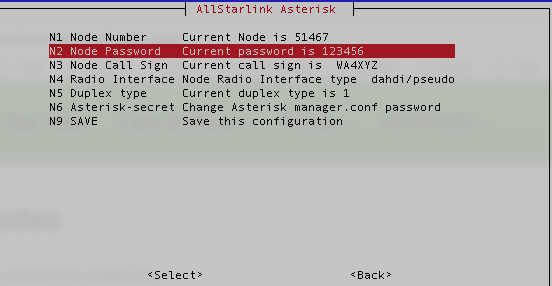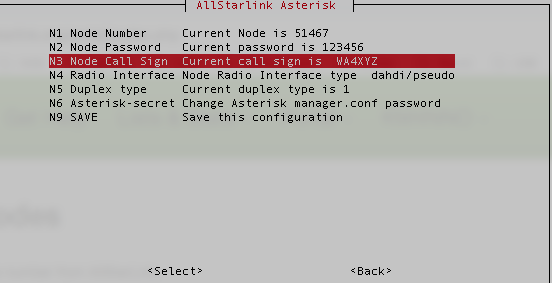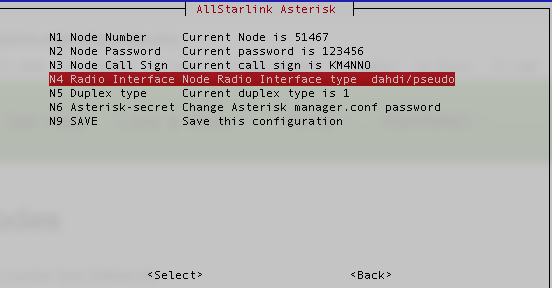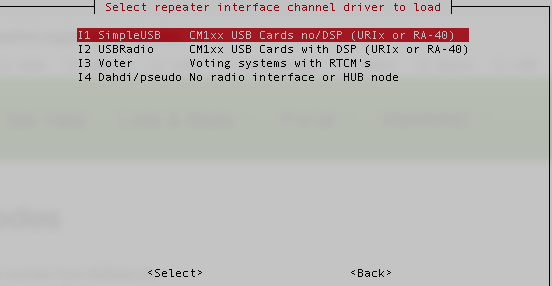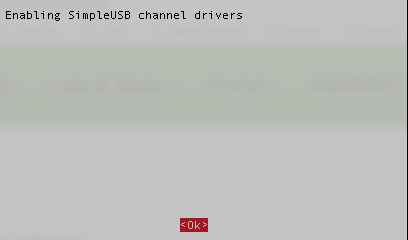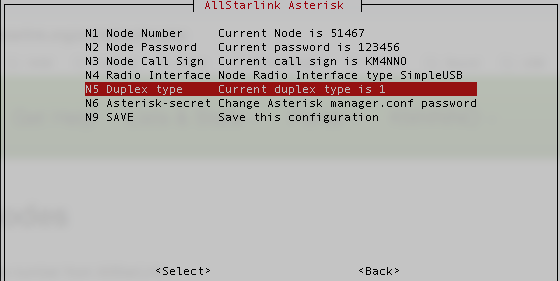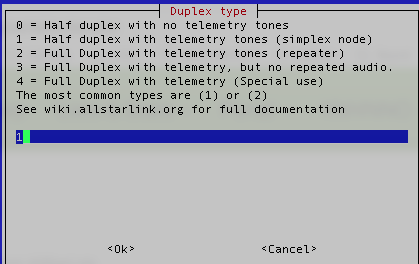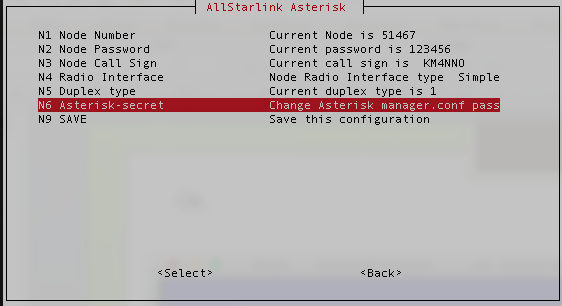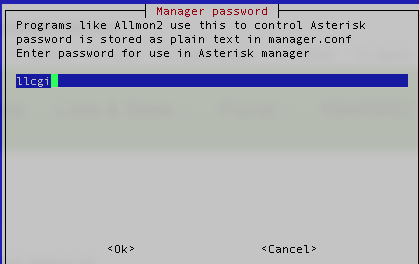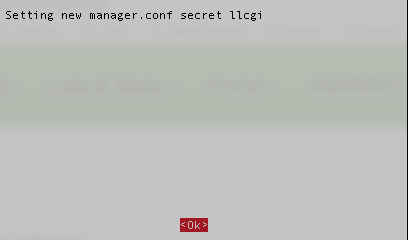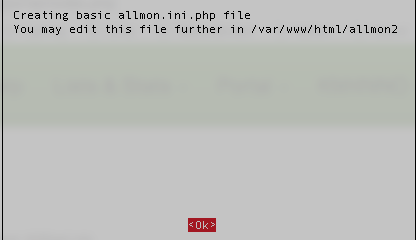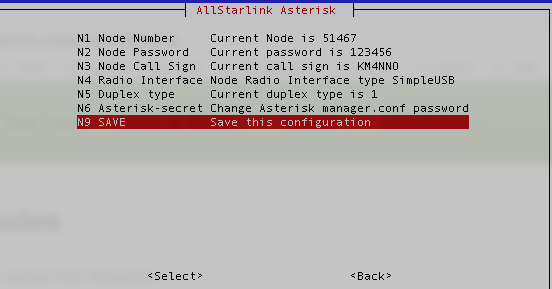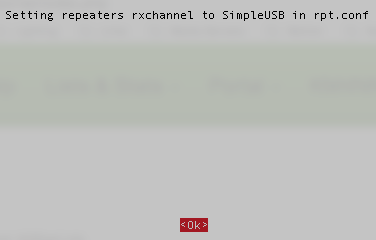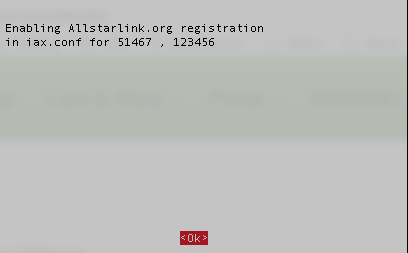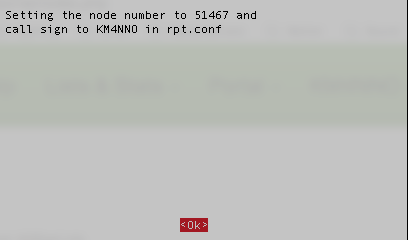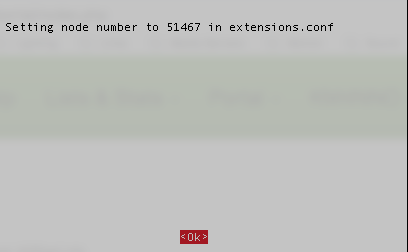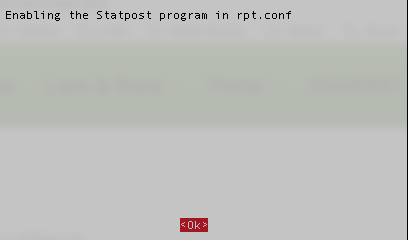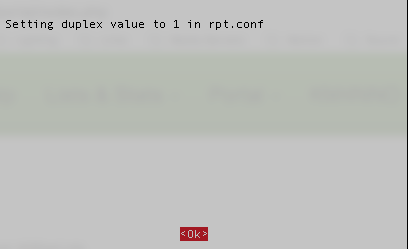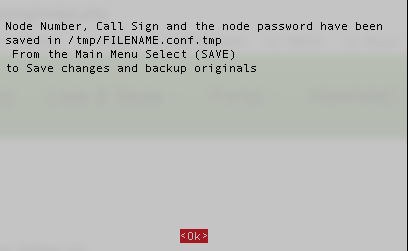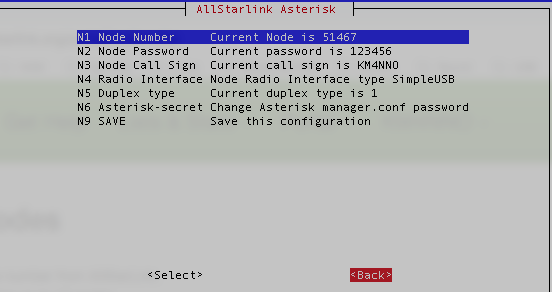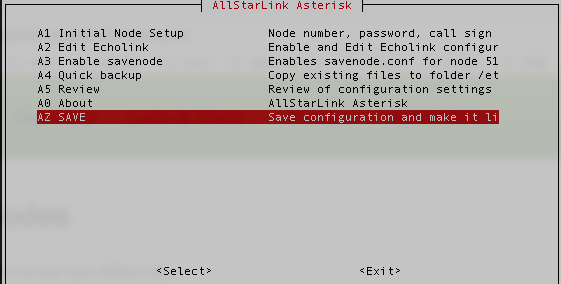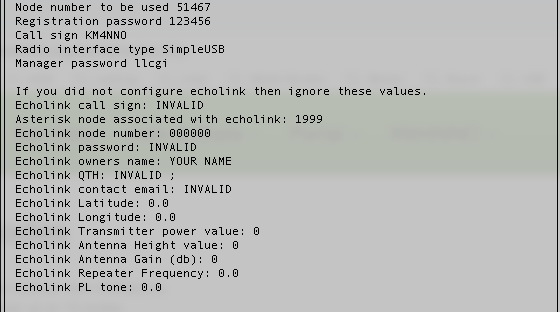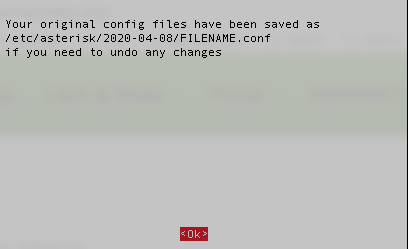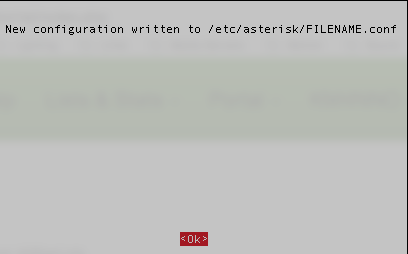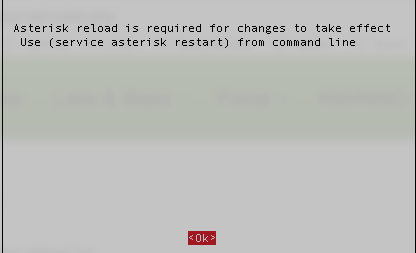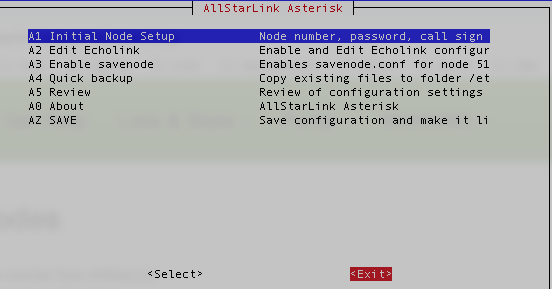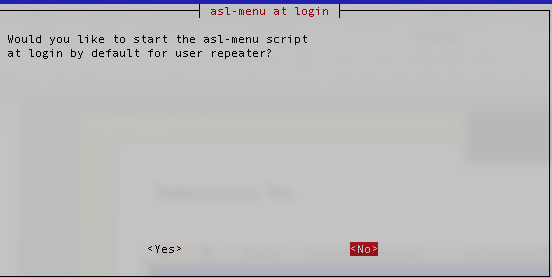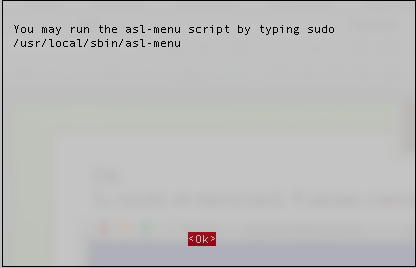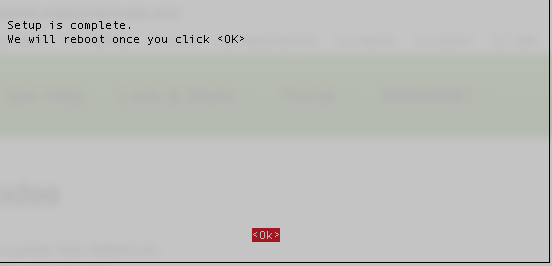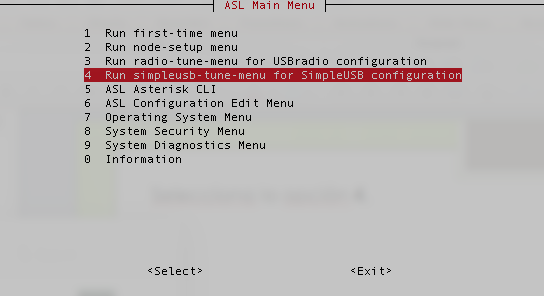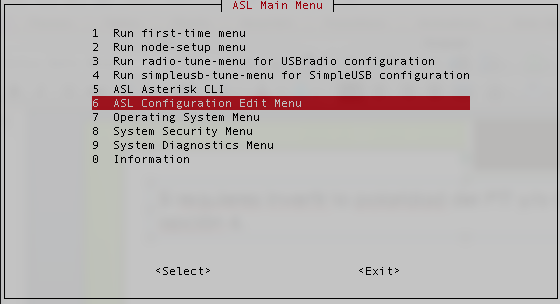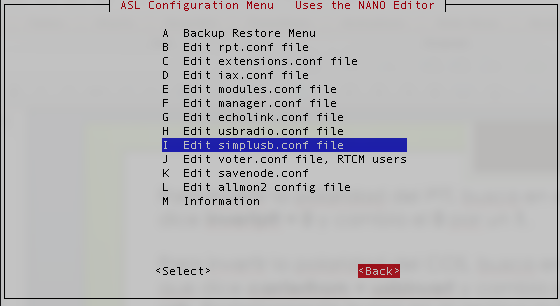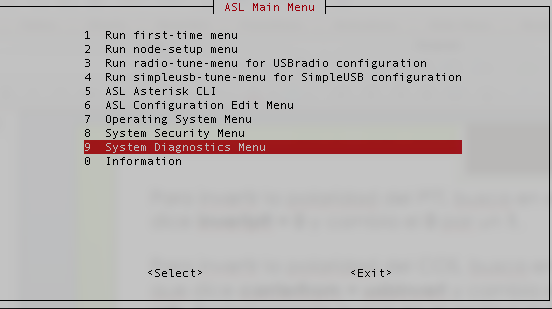Difference between revisions of "Beginners Guide"
imported>KM4NNO m |
imported>KM4NNO (Addded step by step simple configuration.) |
||
| Line 89: | Line 89: | ||
This will load the AllStarLink configuration menu. | This will load the AllStarLink configuration menu. | ||
[[File:Asl menu main screen.png|none|thumb|640x640px]] | [[File:Asl menu main screen.png|none|thumb|640x640px]] | ||
| + | |||
| + | |||
| + | |||
| + | |||
| + | |||
| + | |||
| + | |||
| + | |||
| + | |||
| + | |||
| + | |||
| + | |||
| + | |||
| + | == Configuración del software AllStarLink en tu computadora == | ||
| + | |||
| + | Selecciona la opción '''<1>'''. | ||
| + | [[File:002_first_time.png|none|thumb|640x640px]] | ||
| + | |||
| + | Como es la primer ves que configuras tu nodo, responde '''<Yes>''' para configurar la contraseña para el usuario "'''root'''". No olvides tomar nota del usuario root y su contraseña. | ||
| + | [[File:003_password.png|none|thumb|640x640px]] | ||
| + | |||
| + | Ahora nos preguntará si deseamos cambiar la contraseña del usuario "'''repeater'''", la cual ya habíamos cambiado, así que responde '''<No>''', salvo que nuevamnete la quieas cambiar. No olvides tomar nota. | ||
| + | [[File:004_repeater_password.png|none|thumb|640x640px]] | ||
| + | |||
| + | A continuación haremos el ajuste de la zona horaria, da <Ok>.. | ||
| + | [[File:005_timezone.png|none|thumb|640x640px]] | ||
| + | |||
| + | Selecciona el continente donde estará el nodo. | ||
| + | [[File:006_continent.png|none|thumb|640x640px]] | ||
| + | |||
| + | Selecciona la ciudad horaria donde estará el nodo. | ||
| + | [[File:007_city.png|none|thumb|640x640px]] | ||
| + | |||
| + | A continuación podremos cambiar el nombre de nuestro nodo, el cual por default se llama '''repeater'''. | ||
| + | [[File:008_message.png|none|thumb|640x640px]] | ||
| + | |||
| + | Responde <Yes> para poder hacer los cambios. | ||
| + | [[File:009_edit_hostname.png|none|thumb|640x640px]] | ||
| + | |||
| + | Ingresa el nombre que le quieres dar a tu equipo. y '''<Enter>'''. | ||
| + | [[File:010_hostname.png|none|thumb|640x640px]] | ||
| + | |||
| + | Si deseas configurarlo en un dominio, ingresalo, de lo contrario solo da '''<Enter>'''. | ||
| + | [[File:011_domain_name.png|none|thumb|640x640px]] | ||
| + | |||
| + | Da '''<Ok>''' en el mensaje donde se confirman los cambios que acabas de realizar. | ||
| + | [[File:012_message.png|none|thumb|640x640px]] | ||
| + | |||
| + | Ahora podremos hacer los cambios del DHCP, da '''<Ok>'''. | ||
| + | [[File:013_dhcp.png|none|thumb|640x640px]] | ||
| + | |||
| + | Nuevamente da '''<Ok>'''. | ||
| + | [[File:014_network.png|none|thumb|640x640px]] | ||
| + | |||
| + | Para configurar la red como DHCP o IP Estática, selecciona '''<Yes>'''. | ||
| + | [[File:015_dhcp_static.png|none|thumb|640x640px]] | ||
| + | |||
| + | Selecciona si deseas DHCP con la '''<D>''' o IP estática con la '''<nowiki><S></nowiki>'''. En este ejemplo, seleccioné D, así que la IP será dinámica. | ||
| + | [[File:016_dhcp_static.png|none|thumb|640x640px]] | ||
| + | |||
| + | Just say '''<Ok>''' to this message. | ||
| + | [[File:017_message.png|none|thumb|640x640px]] | ||
| + | |||
| + | Just say '''<Ok>''' to this message. | ||
| + | [[File:018_message.png|none|thumb|640x640px]] | ||
| + | |||
| + | Just say '''<Ok>''' to this message. | ||
| + | [[File:019_message.png|none|thumb|640x640px]] | ||
| + | |||
| + | A continuación ingresaremos el número de nodo. Selecciona la opción '''<A1>''' en el menú. | ||
| + | [[File:020_a_menu_a1.png|none|thumb|640x640px]] | ||
| + | |||
| + | Choose option '''<N1>'''. | ||
| + | [[File:021_n_menu_n1.png|none|thumb|640x640px]] | ||
| + | |||
| + | Type the node number for your node. Yes the one you previously wrote down from AllStarLink site. | ||
| + | [[File:022_node_number.png|none|thumb|640x640px]] | ||
| + | |||
| + | Choose option '''<N2>'''. | ||
| + | [[File:023_n_menu_n2.png|none|thumb|640x640px]] | ||
| + | |||
| + | Type the node password for your node. Yes the one you previously wrote down from AllStarLink site. | ||
| + | [[File:024_node_password.png|none|thumb|640x640px]] | ||
| + | |||
| + | Choose option '''<N3>'''. | ||
| + | [[File:025_n_menu_n3.png|none|thumb|640x640px]] | ||
| + | |||
| + | Type the callsign for your node. Yes the one you previously wrote down from AllStarLink site. | ||
| + | [[File:026_callsign.png|none|thumb|640x640px]] | ||
| + | |||
| + | Choose option '''<N4>'''. | ||
| + | [[File:027_n_menu_n4.png|none|thumb|640x640px]] | ||
| + | |||
| + | Choose option '''<I1>'''. | ||
| + | [[File:028_i_menu_i1.png|none|thumb|640x640px]] | ||
| + | |||
| + | Just say '''<Ok>''' to this message. | ||
| + | [[File:029_message.png|none|thumb|640x640px]] | ||
| + | |||
| + | Choose option '''<N5>'''. | ||
| + | [[File:030_n_menu_n5.png|none|thumb|640x640px]] | ||
| + | |||
| + | If your node will be a simplex node type '''<1>'''. | ||
| + | If your node is a repeater controller type '''<2>'''. | ||
| + | [[File:031_rptr_mode.png|none|thumb|640x640px]] | ||
| + | |||
| + | Choose option '''<N6>'''. | ||
| + | [[File:032_n_menu_n6.png|none|thumb|640x640px]] | ||
| + | |||
| + | Type a new pasword, this will be used to have acces from the nodes web site Allmon2. | ||
| + | [[File:033_password.png|none|thumb|640x640px]] | ||
| + | |||
| + | Just say '''<Ok>''' to this message. | ||
| + | [[File:034_message.png|none|thumb|640x640px]] | ||
| + | |||
| + | Just say '''<Ok>''' to this message. | ||
| + | [[File:036_message.png|none|thumb|640x640px]] | ||
| + | |||
| + | Choose optionn '''<N9>'''. | ||
| + | [[File:037_n_menu_n9.png|none|thumb|640x640px]] | ||
| + | |||
| + | Just say '''<Ok>''' to this message. | ||
| + | [[File:038_message.png|none|thumb|640x640px]] | ||
| + | |||
| + | Just say '''<Ok>''' to this message. | ||
| + | [[File:039_message.png|none|thumb|640x640px]] | ||
| + | |||
| + | Just say '''<Ok>''' to this message. | ||
| + | [[File:040_message.png|none|thumb|640x640px]] | ||
| + | |||
| + | Just say '''<Ok>''' to this message. | ||
| + | [[File:041_message.png|none|thumb|640x640px]] | ||
| + | |||
| + | Just say '''<Ok>''' to this message. | ||
| + | [[File:042_message.png|none|thumb|640x640px]] | ||
| + | |||
| + | Just say '''<Ok>''' to this message. | ||
| + | [[File:043_message.png|none|thumb|640x640px]] | ||
| + | |||
| + | Just say '''<Ok>''' to this message. | ||
| + | [[File:044_message.png|none|thumb|640x640px]] | ||
| + | |||
| + | Choose option '''<Back>'''. | ||
| + | [[File:045_n_menu_back.png|none|thumb|640x640px]] | ||
| + | |||
| + | Choose option '''<AZ>'''. | ||
| + | [[File:046_a_menu_az.png|none|thumb|640x640px]] | ||
| + | |||
| + | Review what you wrote down with what you have configured on your systemand press '''<Enter>'''. | ||
| + | [[File:047_review.png|none|thumb|640x640px]] | ||
| + | |||
| + | Choose '''<Yes>''' to backup your configuration. | ||
| + | [[File:048_backup.png|none|thumb|640x640px]] | ||
| + | |||
| + | Just say '''<Ok>''' to this message. | ||
| + | [[File:049_message.png|none|thumb|640x640px]] | ||
| + | |||
| + | Just say '''<Ok>''' to this message. | ||
| + | [[File:050_message.png|none|thumb|640x640px]] | ||
| + | |||
| + | Just say '''<Ok>''' to this message. | ||
| + | [[File:051_message.png|none|thumb|640x640px]] | ||
| + | |||
| + | Choose option '''<Exit>'''. | ||
| + | [[File:052_a-menu_exit.png|none|thumb|640x640px]] | ||
| + | |||
| + | Answer '''<Yes>''', because we already saved our configuration. | ||
| + | [[File:053_exit.png|none|thumb|640x640px]] | ||
| + | |||
| + | If you want to automatically start your system with this menu answer '''<Yes>''', if not then '''<No>'''. | ||
| + | [[File:054_select_menu_sartup.png|none|thumb|640x640px]] | ||
| + | |||
| + | If you answer was '''<No>''', remember you can come back to this menu typing '''sudo asl-menu''' as the following example: | ||
| + | |||
| + | repeater@repeater:~$ sudo asl-menu | ||
| + | |||
| + | [[File:055_message.png|none|thumb|640x640px]] | ||
| + | |||
| + | Now your node will reboot to apply all the changes we have done, so say '''<Ok>'''. | ||
| + | [[File:056_reboot.png|none|thumb|640x640px]] | ||
| + | |||
| + | == AllStarLink Audio settings with SimpleUSB == | ||
| + | |||
| + | type '''sudo asl-menu''' like the example bellow: | ||
| + | |||
| + | repeater@repeater:~$ sudo asl-menu | ||
| + | |||
| + | Choose option '''<4>'''. | ||
| + | [[File:101_asl_menu_4.png|none|thumb|640x640px]] | ||
| + | |||
| + | With option '''<F>''', will triger PTT few times on your radio for testing, you should also listen a test tone. | ||
| + | |||
| + | Next, with option '''<2>''', you can adjust the audio levels from your radio to your node node with the aim of an on-screen level meter. | ||
| + | |||
| + | With another radio transmit a test tone or voice and type values between 0 and 999 followed by '''<Enter>''' to apply them, if you do not set any value and hit '''<Enter>''', you will exit this function keeping the last typed value on RAM. | ||
| + | |||
| + | Next, type option '''<T>''', you can toggle a tone generator to adjust your node to radio audio levels, so type it once to turn it on. | ||
| + | |||
| + | Now typing option '''<3>''', will allow you to adjust the audio from your node to your Tx radio. | ||
| + | |||
| + | To achieve that, you can type values between 0 and 999 and press '''<Enter>''' to apply the new value. The system will Tx a test tone for 5 seconds. If you do not set any value and hit '''<Enter>''', you will exit this function keeping the last typed value on RAM. | ||
| + | |||
| + | Do not forget to turn of the tone generator by pressing once again '''<T>'''. | ||
| + | |||
| + | Once you are happy with your settings, type '''<W>''' and '''<Enter>'''. | ||
| + | |||
| + | To exit from this menu type '''<0>''' (zero) and hit '''<Enter>'''. | ||
| + | |||
| + | == PTT and COS polarity settings == | ||
| + | |||
| + | If your radio, need PTT and/or COS/CTCSS polarity to be inverted go to the mail ASL menu and choose option '''<6>'''. | ||
| + | [[File:103_asl_menu_6.png|none|thumb|640x640px]] | ||
| + | |||
| + | Choose option '''<nowiki><I></nowiki>'''. | ||
| + | [[File:104_config_menu_i.png|none|thumb|640x640px]] | ||
| + | |||
| + | You will be logger to a text file where you will need to find and edit some values: | ||
| + | |||
| + | PTT invert: | ||
| + | |||
| + | Search for the line begining with '''invertptt =''' and change its value as follows: | ||
| + | |||
| + | '''0''' = Ground to Tramsmit. | ||
| + | |||
| + | '''1''' = Open to Transmit. | ||
| + | [[File:105_invertptt.png|none|thumb|640x640px]] | ||
| + | |||
| + | COS/CTCSS invert: | ||
| + | |||
| + | Search for the line begining with '''carrierfrom =''' and change its value as follows. | ||
| + | |||
| + | Search for the line begining with '''ctcssfrom =''' and change its value as follows. | ||
| + | |||
| + | '''no''' = No carrier detection at all. | ||
| + | |||
| + | '''usb''' = Cor line active Hi. | ||
| + | |||
| + | '''usbinvert''' = Cor line active Low. | ||
| + | [[File:106_invertcos.png|none|thumb|640x640px]] | ||
| + | |||
| + | After making your changes type '''<CTRL> + <X>''' and then type '''<Y>''' followed by '''<Enter>'''. You will be back to the previous menu and choose '''<Back>'''. | ||
| + | |||
| + | [[File:107_asl_menu_9.png|none|thumb|640x640px]] | ||
| + | |||
| + | Choose option '''<G>''' to restar AllStarLink software and apply changes. Choose '''<Back>''', repeat your audio test if needed. | ||
| + | [[File:107_asl_menu_9.png|none|thumb|640x640px]] | ||
| + | |||
| + | At this point your node should be up and running. | ||
| + | |||
| + | == Allmon2 Setup. == | ||
| + | |||
| + | TBD | ||
| + | |||
| + | == Allmon2 web control. == | ||
| + | |||
| + | TBD | ||
| + | |||
| + | == DTMF control. == | ||
| + | |||
| + | TBD | ||
Revision as of 22:08, 9 April 2020
AllStarLink for beginners.
The first step is to create an account.
Go to https://allstarlink.org/ and click the <Sign Up> link.
Download ASL image file
While you are awaiting the verification of your account (usually within 24 hours) you may download one of the image files for you computer system you will use to run your AllStarLink node.
Go to wiki.allstarlink.org scroll down to the Downloads section and select the appropriate image for the type of system you will use.
Write the image file to media. Either a USB memory stick, CD or DVD, or a microSD card (Raspberry Pi).
Login to your account
You will need to login to your account at https://allstarlink.org/
Click on <Login/SignUp> as shown in the image above.
Create a Server
You will need to create a "server" : Click on <Portal> then <Server Settings>.
Click on <Add a new server>.
Please take the time to read the instructions on each page.
Then click <Proceed with Server Setup> if needed.
Fill in all of the information and click <Submit> at the bottom of the page.
Request a Node number
At the top of the page, click <Portal> and then on <Node Settings>.
Then click <Request a new node number>.
Select which server you would wish to have a node number assigned to
if you need more than one node number for the same server, repeat this process
A comment of 'additional node on same server' would be appropriate
Once your node number request(s) are processed you will receive an email.
Edit Node settings
Log into your account on https://allstarlink.org/
Click <Portal> then <Node settings>.
The AllStarLink node numbers that have been assigned to you are displayed here.
Select which node you wish to view/edit.
Fill in the information for you node and click <Submit>.
Write down your node number, password and the call sign you assigned for the node as you will use them to configure your AllStarLink system.
Install and configure ASL to your computer
Consult your owners manual or your favorite internet search engine for how to install an image for your computer system.
Install the AllStarLink disk image to your computer. Insert the appropriate media for your system and boot the computer.
When the login prompt appears enter the user ID of repeater and press <Enter>.
Enter the default password of allstarlink
Follow the on screen instructions for the initial password change.
For users familiar with the linux operation system you may proceed to edit the system manually.
For users not familiar with linux and ASL, at the Linux CLI (command line interface)
Type sudo asl-menu as the example below shows.
repeater@repeater:~$ sudo asl-menu
This will load the AllStarLink configuration menu.
Configuración del software AllStarLink en tu computadora
Selecciona la opción <1>.
Como es la primer ves que configuras tu nodo, responde <Yes> para configurar la contraseña para el usuario "root". No olvides tomar nota del usuario root y su contraseña.
Ahora nos preguntará si deseamos cambiar la contraseña del usuario "repeater", la cual ya habíamos cambiado, así que responde <No>, salvo que nuevamnete la quieas cambiar. No olvides tomar nota.
A continuación haremos el ajuste de la zona horaria, da <Ok>..
Selecciona el continente donde estará el nodo.
Selecciona la ciudad horaria donde estará el nodo.
A continuación podremos cambiar el nombre de nuestro nodo, el cual por default se llama repeater.
Responde <Yes> para poder hacer los cambios.
Ingresa el nombre que le quieres dar a tu equipo. y <Enter>.
Si deseas configurarlo en un dominio, ingresalo, de lo contrario solo da <Enter>.
Da <Ok> en el mensaje donde se confirman los cambios que acabas de realizar.
Ahora podremos hacer los cambios del DHCP, da <Ok>.
Nuevamente da <Ok>.
Para configurar la red como DHCP o IP Estática, selecciona <Yes>.
Selecciona si deseas DHCP con la <D> o IP estática con la <S>. En este ejemplo, seleccioné D, así que la IP será dinámica.
Just say <Ok> to this message.
Just say <Ok> to this message.
Just say <Ok> to this message.
A continuación ingresaremos el número de nodo. Selecciona la opción <A1> en el menú.
Choose option <N1>.
Type the node number for your node. Yes the one you previously wrote down from AllStarLink site.
Choose option <N2>.
Type the node password for your node. Yes the one you previously wrote down from AllStarLink site.
Choose option <N3>.
Type the callsign for your node. Yes the one you previously wrote down from AllStarLink site.
Choose option <N4>.
Choose option <I1>.
Just say <Ok> to this message.
Choose option <N5>.
If your node will be a simplex node type <1>. If your node is a repeater controller type <2>.
Choose option <N6>.
Type a new pasword, this will be used to have acces from the nodes web site Allmon2.
Just say <Ok> to this message.
Just say <Ok> to this message.
Choose optionn <N9>.
Just say <Ok> to this message.
Just say <Ok> to this message.
Just say <Ok> to this message.
Just say <Ok> to this message.
Just say <Ok> to this message.
Just say <Ok> to this message.
Just say <Ok> to this message.
Choose option <Back>.
Choose option <AZ>.
Review what you wrote down with what you have configured on your systemand press <Enter>.
Choose <Yes> to backup your configuration.
Just say <Ok> to this message.
Just say <Ok> to this message.
Just say <Ok> to this message.
Choose option <Exit>.
Answer <Yes>, because we already saved our configuration.
If you want to automatically start your system with this menu answer <Yes>, if not then <No>.
If you answer was <No>, remember you can come back to this menu typing sudo asl-menu as the following example:
repeater@repeater:~$ sudo asl-menu
Now your node will reboot to apply all the changes we have done, so say <Ok>.
AllStarLink Audio settings with SimpleUSB
type sudo asl-menu like the example bellow:
repeater@repeater:~$ sudo asl-menu
Choose option <4>.
With option <F>, will triger PTT few times on your radio for testing, you should also listen a test tone.
Next, with option <2>, you can adjust the audio levels from your radio to your node node with the aim of an on-screen level meter.
With another radio transmit a test tone or voice and type values between 0 and 999 followed by <Enter> to apply them, if you do not set any value and hit <Enter>, you will exit this function keeping the last typed value on RAM.
Next, type option <T>, you can toggle a tone generator to adjust your node to radio audio levels, so type it once to turn it on.
Now typing option <3>, will allow you to adjust the audio from your node to your Tx radio.
To achieve that, you can type values between 0 and 999 and press <Enter> to apply the new value. The system will Tx a test tone for 5 seconds. If you do not set any value and hit <Enter>, you will exit this function keeping the last typed value on RAM.
Do not forget to turn of the tone generator by pressing once again <T>.
Once you are happy with your settings, type <W> and <Enter>.
To exit from this menu type <0> (zero) and hit <Enter>.
PTT and COS polarity settings
If your radio, need PTT and/or COS/CTCSS polarity to be inverted go to the mail ASL menu and choose option <6>.
Choose option <I>.
You will be logger to a text file where you will need to find and edit some values:
PTT invert:
Search for the line begining with invertptt = and change its value as follows:
0 = Ground to Tramsmit.
1 = Open to Transmit.
COS/CTCSS invert:
Search for the line begining with carrierfrom = and change its value as follows.
Search for the line begining with ctcssfrom = and change its value as follows.
no = No carrier detection at all.
usb = Cor line active Hi.
usbinvert = Cor line active Low.
After making your changes type <CTRL> + <X> and then type <Y> followed by <Enter>. You will be back to the previous menu and choose <Back>.
Choose option <G> to restar AllStarLink software and apply changes. Choose <Back>, repeat your audio test if needed.
At this point your node should be up and running.
Allmon2 Setup.
TBD
Allmon2 web control.
TBD
DTMF control.
TBD



